US lifts Indian import tariff to 50% with new 25% hike
India calls the move 'extremely unfortunate', says imports are market-driven and aimed at energy security
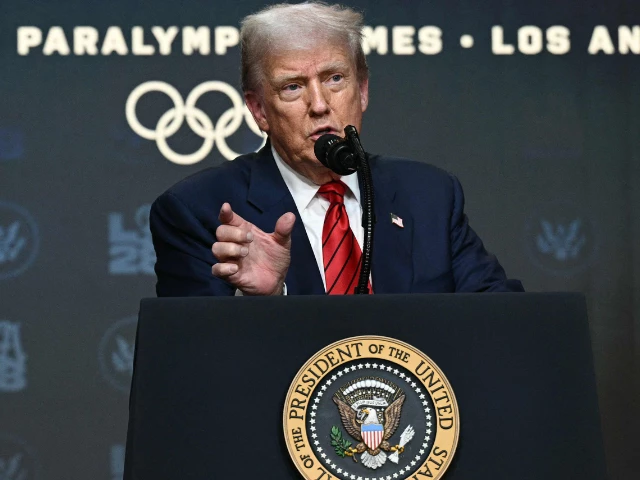
US President Donald Trump on Wednesday signed an executive order imposing an additional 25% tariff on goods imported from India, doubling the total tariff to 50%, the White House said.
The move comes in response to India’s continued direct and indirect imports of oil from the Russian Federation, which the administration said undermines US foreign policy and economic interests.
According to the order, all articles imported into the United States from India will now be subject to an additional ad valorem duty of 25 per cent.
Also Read: US releases report on Titan submersible implosion
“The President has determined it is necessary and appropriate to impose an additional ad valorem rate of duty on imports of articles from India,” the White House said in a statement, adding that the action was in response to India’s continued engagement with Russian energy exports despite geopolitical concerns.
The executive order states that India’s trade practices related to Russian oil undermine US foreign policy objectives and warrant corrective economic measures.
The order also threatens potential penalties on other countries deemed to be "directly or indirectly importing Russian Federation oil."
Trump's executive order does not mention China, which also buys Russian oil. A White House official had no immediate comment on whether an additional order covering those purchases would be forthcoming.
Statement by Official Spokesperson⬇️
— Randhir Jaiswal (@MEAIndia) August 6, 2025
🔗 https://t.co/BNwLm9YmJc pic.twitter.com/DsvRvhd61D
India's external affairs ministry said in a statement, saying it was "extremely unfortunate that the US should choose to impose additional tariffs on India for actions that several other countries are also taking in their own national interest."
It said India's imports were based on market factors and aimed at energy security for its population of 1.4 billion.
The tariff is set to take effect in three weeks and would be added on top of a separate 25 per cent tariff entering into force on Thursday. It maintains exemptions for items targeted by separate sector-specific duties such as steel and aluminum, and categories that could be hit like pharmaceuticals.
Read: Bangladesh polls to be held in Feb 2026
The new measure raises tariffs on some Indian goods to as high as 50% – among the steepest faced by any US trading partner. The move is expected to hit key Indian export sectors including textiles, footwear, and gems and jewellery and marks the most serious downturn in US-India relations since Trump returned to office in January.
It also comes as Indian Prime Minister Narendra Modi prepares for his first visit to China in over seven years, suggesting a potential realignment in alliances as ties with Washington fray.
'Trade between two nations practically dead'
Trade analysts warned the tariffs could severely disrupt Indian exports.
"With such obnoxious tariff rates, trade between the two nations would be practically dead," said Madhavi Arora, economist at Emkay Global.
Indian officials have privately acknowledged growing pressure to return to the negotiating table. A potential compromise could involve a phased reduction in Russian oil imports and diversification of energy sources.
A senior Indian official said New Delhi was blindsided by the sudden imposition of the new levy and the steep rate, as both countries continue to discuss trade issues.
Also Read: Northern India rescue ops hampered by rain, landslides
Trump's decision follows five rounds of inconclusive trade negotiations, which stalled over US demands for greater access to Indian agriculture and dairy markets.
India's refusal to curb Russian oil purchases – which surged to a record $52 billion last year – ultimately triggered the tariff escalation.
"Exports to the US become unviable at this rate. Clearly, risks to growth and exports are rising, and the rupee may face renewed pressure," said Garima Kapoor, economist at Elara Securities. "Calls for fiscal support are likely to intensify."
Trump has been ramping up pressure on India after signaling fresh sanctions on Moscow if it did not make progress by Friday towards a peace deal with Kyiv, as Russia's devastating invasion of its pro-western neighbor drags on.
On Monday, the President Trump threatened to "substantially" raise US tariffs on Indian goods over the country's continued purchases of Russian oil — a key source of funding for Moscow’s war in Ukraine.
In a post to his Truth Social platform, the president said that India was "buying massive amounts of Russian Oil" and selling it for "big profits."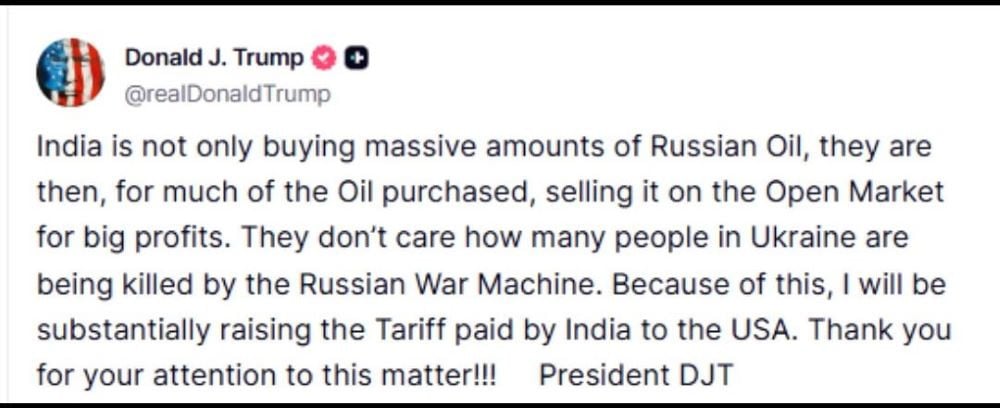
"They don't care how many people in Ukraine are being killed by the Russian War Machine," Trump added. "Because of this, I will be substantially raising the tariff paid by India to the USA."
Hours after mentioning a possible tariff hike on India, Trump said again on Tuesday that he would increase the tariff charged on imports from India from the current rate of 25% "very substantially" within the next 24 hours, citing New Delhi's continued purchases of Russian oil.
"They're fueling the war machine, and if they're going to do that, then I'm not going to be happy," Trump told CNBC in an interview.
Read More: Missed signals, lost deal: How India-US trade talks collapsed
India's national security adviser was in Moscow on Wednesday, media in New Delhi reported, coinciding with a visit by US envoy Steve Witkoff.
India's foreign ministry earlier said US pressure to stop it buying Russian oil was "unjustified and unreasonable" and that it would protect its interests.
Moscow is anticipating talks this week with the US leader's special envoy Steve Witkoff, and the Kremlin has criticized Trump's threat of raising tariffs on Indian goods.


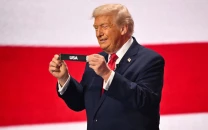
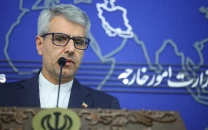







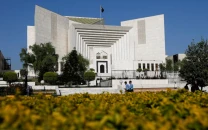









COMMENTS
Comments are moderated and generally will be posted if they are on-topic and not abusive.
For more information, please see our Comments FAQ